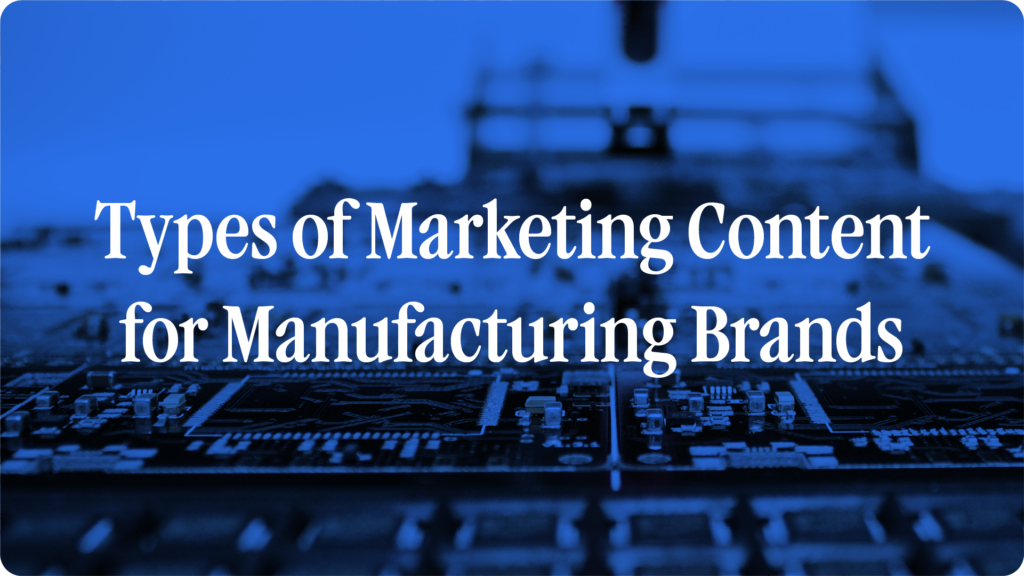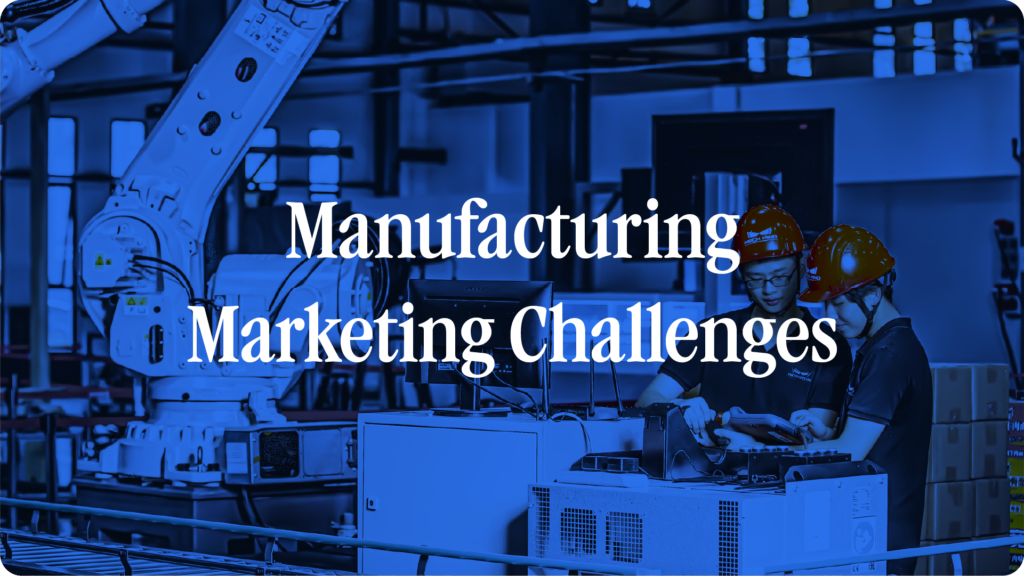by Lee Dussinger
“If you build it, they will come” – unfortunately for the manufacturing industry, that’s not always the case. You can build the most amazing product in the world – but if no one knows about it, understands its value, and imagines how they’ll feel using it, no one will be buying. This is exactly why marketing for manufacturing companies is such a competitive field – specifically around marketing content.
According to the Content Marketing Institute (CMI), 75% of manufacturing industry marketers say that content marketing is a MAJOR piece of their strategy. Per that same CMI report, these brands use content marketing to drive their primary business objectives:
- 71% of manufacturing content marketers use it for lead generation
- 88% of marketers use it to create brand awareness
- 67% of manufacturing brands employ content to build trust
- 63% use content marketing to educate their consumer base
Opal’s content marketing platform is used by many international manufacturing brands, like GM, 3M, and Boeing. This gives us insight into the strategies they use and the difficulties they encounter. We’re shining a light on the challenges of content marketing for manufacturing, providing insights into strategy, and showing why top manufacturing brands choose the Opal platform.
Types of Marketing Content for Manufacturing Brands

As you’d expect from content marketing campaigns in 2023, nearly every vertical that exists is leveraged by the majority of manufacturers. However, the two most popular types of marketing content for manufacturing brands are: video and short-form social posts. By the numbers, 86% of marketers list videos as their top content type – while short-form social posts are listed as a top choice by 83% of marketers.
The other most popular types of marketing content for manufacturing companies (and what percentage of marketers list it as a top choice) are as follows:
- Virtual events/webinars: 70%
- Infographics/charts/visualization: 50%
- Case studies: 46%
- E-books/white papers: 46%
- Long-form blog posts (3,000+ words): 45%
- Print magazines: 33%
- Content live streams: 30%
- Podcasts: 22%
- Research reports: 15%
For many manufacturers differentiating themselves with marketing content isn’t about the format, but instead about the narrative they craft. These are the large, thematic types of marketing for manufacturing brands:
How it’s made – This style of content focuses on the process that brings their focal point product to life. Hallmarks of this type of marketing content for manufacturing are machines and craftsmen building something. The rhetorical thrust here is that the process behind the product is what makes it exceptional. By highlighting the story of how it’s built, you can showcase the tangible product qualities that make it stand out.
How it makes people feel – This type of content is aspirational, first and foremost. By showing people using – and enjoying – your product, you make the suggestion of how the viewer will feel. Think of every commercial you’ve ever seen of a happy family on a road trip in their brand new vehicle. Parents (hopefully in the market for a new SUV) see this and imagine themselves as the happy family – and more importantly, they want that feeling. If any of the car’s features happen to land, that’s just a bonus onto the feeling.
How it connects to culture – Think sponsorships, brand deals, and product tie-ins. Sometimes, the very best thing about your product is how it fits in with something people LOVE more. Whether that’s a corporate sponsorship or a cultural association, with this type of story, you’re trading on the goodwill people have for something – and associating your brand’s story with that. Think of Chevy’s MLB sponsorship: a player celebrating their World Series win is handed the keys to a new Chevy Truck or a Corvette. The connection couldn’t be more apparent that those cars go hand-in-hand with baseball’s biggest moments. Another, very topical, example of this is the placement of both GM cars and the logo in Barbie!
Manufacturing Marketing Challenges

When executed correctly, content marketing proves very effectively at driving business outcomes for manufacturing brands. However, it’s not without difficulties. These are the primary manufacturing marketing challenges:
Siloed Organizations – This certainly doesn’t apply to every single marketing org for every manufacturer. However, it’s not uncommon for teams and brands to be siloed around specific regions and product lines. The challenge this creates is that staying aligned across the organization is far more difficult. This can lead to conflicting messaging or widely different tones in the market – or simply just confusion as to what’s going on.
Needing to Do More with Less –Per CMI’s survey, 75% of respondents reported being asked to produce more content with the same (or less) resources. If you’re like three fourths of the responders, you’re being asked to expand your impact without expanding your budget. Practically, this means all the same types of marketing content for your manufacturing brand – just more of everything – without sacrificing quality.
High-Profile, Visual Content – When marketing a product you manufacture, you need to make sure your image looks perfect. Your visuals matter and even one small mistake can undermine the story you’re telling. With so much content being produced daily, it’s easy to accidentally reuse similar product images or videos. Even worse, you might accidentally use a similar but incorrect product image or video clip. In addition, when your audience has affinity for your brand, they’ll catch even the most minute mistakes in the original images.
Navigating Necessary Red Tape – Oftentimes in the manufacturing space, content must pass through a series of approvals before it can make it to the market. That can look like legal reviews or strict corporate brand governance. While these steps are essential to ensure content is appropriate per your (oftentimes legal) standards, it can be a challenge for the marketers looking to publish in a timely manner.
Complexity of Content Campaigns – Any national or international brand will necessitate personalized marketing strategies. Content for the manufacturing sectors adds several other layers of difficulty onto this. Why is it so complicated? Your marketing is likely heavily segmented. Different customers get different messaging based on demographics and buying history. Of course, it’s also likely regional, where different areas receive different marketing. Of course, there’s also a canopy of personalization based on buying behavior and demographics. All this to say, keeping track of everything going on is a herculean task!
Global Reach – Holding the reins of a brand that has a global reach is an exciting opportunity. Of course, this reach also makes creating content challenging. Content needs to be specified to the people and the culture of those regions. Oftentimes, managing a global brand hinges on The Hub and Spoke Marketing Model – which disseminates approved content for localization! While this model is an effective way to handle content creation, managing this system still proves challenging.
Why Manufacturing Brands Choose Opal for Content Marketing
Manufacturing brands could choose any number of platforms to plan, create, and calendar their marketing content. However, many Fortune 500 manufacturers trust Opal.
That is because Opal offers a variety of purpose-built features that solve problems marketers experience every day. These are the capabilities that make Opal a fit, specifically in content marketing for manufacturing:
True-to-Life Content Visualization – There’s no substitute for seeing your content exactly as your audience will. Opal offers true-to-life content previews that enable you to visualize every aspect of your content as if it were in the native publishing environment. Not only does this make reviews more helpful, but this visualization can help content creators create stronger first drafts as well!
Time-Reclaiming Workflows – When your team is large and the workstreams are complex, things can get bogged down. Our automated workflows, which activate the right people at the right time, can keep you moving quickly. This is particularly valuable for navigating multifaceted content reviews.
See how Microsoft achieved 50% faster content approvals by using Opal.
Visual Calendar for Organization – Here’s how you break out of silos! Marketing for manufacturing can be complex, but Opal’s shared, central publication calendar provides the visibility necessary to understand every aspect of your campaigns. With a central source of truth, you can understand who is getting what messaging, in what location, and at what time!
Purpose-Built Localization Features – When you’re managing a global brand, a unique set of challenges come along with that. Opal provides specific feature sets meant specifically for global marketing that our competitors don’t offer. See how our newly released AI Translate feature is a game changer for global teams!
Auto-Build Presentations – Another time-saving feature, Opal’s auto-build presentations enable you to build professional-looking decks in seconds. Perfect for sharing a wrap-up of published work – or requesting content reviews. With this, you’ll never need to build another PowerPoint by hand ever again!
See Your Content in the Opal Platform
Opal is the marketing platform that brands like GM, Boeing, and many more trust as their source of truth for marketing. That’s because Opal gives you the power to unlock your best brainstorming, perform detailed reviews, and take your brand to the next level.
Ready to witness the magic of the Opal platform? Here’s how you can get started:
- You can request a personalized demo from our product specialists, who will take you through the platform’s extensive capabilities and show you how Opal can help you transform your manufacturing marketing planning!
- If you’d rather get your hands on Opal, you can try our free 14-day trial and get full access to Opal’s unlimited features. Start planning, creating, and calendaring for your manufacturing brand today!


